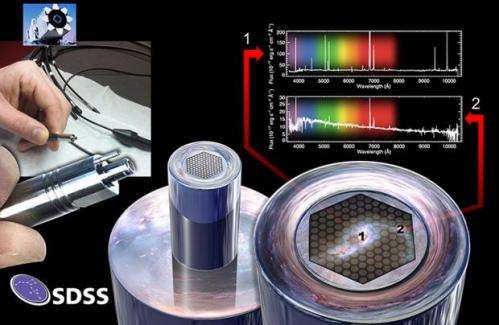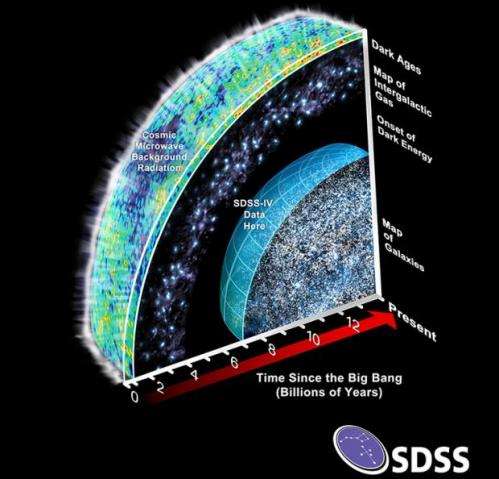New survey begins mapping nearby galaxies

A new survey called MaNGA (Mapping Nearby Galaxies at Apache Point Observatory) has been launched that will greatly expand our understanding of galaxies, including the Milky Way, by charting the internal structure and composition of an unprecedented sample of 10,000 galaxies.
MaNGA is a part of the fourth generation Sloan Digital Sky Survey (SDSS-IV) and will make maps of stars and gas in galaxies to determine how they have grown and changed over billions of years, using a novel optical fiber bundle technology that can take spectra of all parts of a galaxy at the same time.
The new survey represents a collaboration of more than 200 astronomers at more than 40 institutions on four continents. With the new technology, astronomers will gain a perspective on the building blocks of the universe with a statistical precision that has never been achieved before.
"Because the life story of a galaxy is encoded in its internal structure—a bit like the way the life story of a tree is encoded in its rings—MaNGA would, for the first time, enable us to map the evolutionary histories of galaxies of all types and sizes, living in all kinds of environments," said Kevin Bundy, MaNGA's Principal Investigator from the Kavli Institute of the Physics and Mathematics of the Universe, the University of Tokyo.
This new survey will provide a vast public database of observations that will significantly expand astronomer's understanding of how tiny differences in the density of the early universe evolved over billions of years into the rich structure of galaxies today. This cosmic story includes the journey of our own Milky Way galaxy from its origins to the birth of our sun and solar system, and eventually the necessary conditions that gave rise to life on Earth.
"MaNGA will not only teach us about what shapes the appearance of normal galaxies," said SDSS Project Scientist, Matthew Bershady from the University of Wisconsin, Madison. "It will also almost surely surprise us with new discoveries about the origin of dark matter, super-massive black holes, and perhaps even the nature of gravity itself." This potential comes from MaNGA's ability to paint a complete picture of each galaxy using an unprecedented amount of spectral information on the chemical composition and motions of stars and gas.
To realize this potential, the MaNGA team has developed new technologies for bundling sets of fiber-optic cables into tightly-packed arrays that dramatically enhance the capabilities of existing instrumentation on the 2.5-meter Sloan Foundation Telescope in New Mexico. Unlike nearly all previous surveys, which combine all portions of a galaxy into a single spectrum, MaNGA will obtain as many as 127 different measurements across the full extent of every galaxy. Its new instrumentation enables a survey of more than 10,000 nearby galaxies at twenty times the rate of previous efforts, which did one galaxy at a time.

But local galaxy studies are far from the only astronomical topic the new SDSS will explore. Another core program called APOGEE-2 will chart the compositions and motions of stars across the entire Milky Way in unprecedented detail, using a telescope in Chile along with the existing Sloan Foundation Telescope.
And the new SDSS will continue to improve our understanding of the Universe as a whole. The third core program, eBOSS, will precisely measure the expansion history of the Universe through 80% of cosmic history, back to when the Universe was less than three billion years old. These new detailed measurements will help to improve constraints on the nature of dark energy, the most mysterious experimental result in modern physics.
"SDSS has a proud history of fostering a breadth of cosmic discoveries that connect a deep understanding of the origins of the universe with key insights on the nature of galaxies and the makeup of our own Milky Way," said Hitoshi Murayama, Director of the Kavli IPMU. "We are delighted to be a part of this endeavor to understand the Universe in the broadest sense, and particularly happy to see our Kevin Bundy playing such a crucial role to make it all happen."
With new technology and surveys like MaNGA and the continuing generous support of the Alfred P. Sloan Foundation and participating institutions, the SDSS will remain one of the world's most productive astronomical facilities. Science results from the SDSS will continue to reshape our view of the fundamental constituents of the cosmos, the universe of galaxies, and our home in the Milky Way.
Provided by University of Tokyo


















